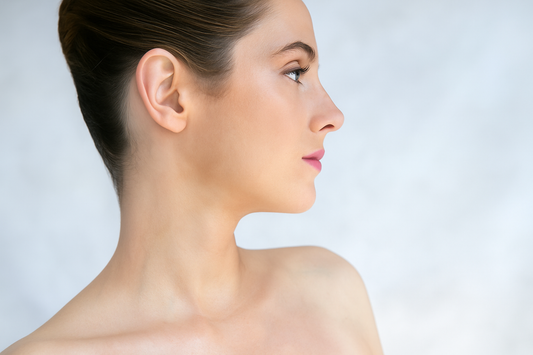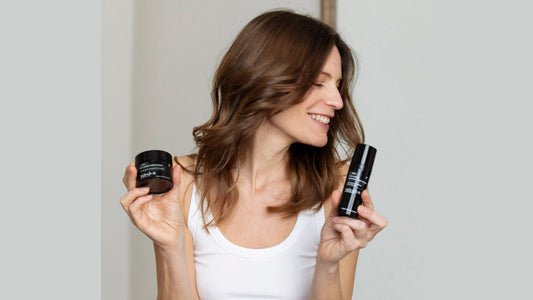The skin is the largest organ in the human body and plays a vital role in protecting the body against external aggressions, regulating temperature and eliminating toxins. Skin can be classified into different types depending on its texture, sensitivity and hydration level, among other factors.
Although skin often changes over time and environmental conditions, meaning that even people who have been diagnosed with oily or dry skin can experience different levels of oiliness and dryness at different times. So we don't like to put too many labels on the skin and our goal at Method R is to help everyone achieve the healthiest skin possible.
The different types of skin
Two of the most common skin types are oily skin and dry skin. Next, we will explain their differences and how to balance their fat production until they are as similar as possible to normal skin.
Oily skin
Oily skin is characterized by excessive production of sebum by the sebaceous glands. Sebum is a greasy substance that acts as a natural lubricant for the skin and helps keep it hydrated. However, in oily skin, sebum production is greater than necessary, which can lead to a shiny appearance, enlarged pores, and blackheads. Oily skin is also more prone to the appearance of pimples and blackheads.
The causes of oily skin can be multiple, such as genetics, diet, stress and hormones, among other factors. Climate can also influence sebum production, as the skin tends to produce more sebum in hot, humid climates.
Dry Skin
On the other hand, dry skin is characterized by a lack of sebum production and poor moisture retention. Dry skin may feel rough to the touch, tight, and often appear cracked or scaly. Dry skin is more prone to the appearance of wrinkles and fine lines due to loss of elasticity.
The causes of dry skin can also be varied, such as genetics, age, exposure to dry or cold climates, exposure to chemicals, and other environmental factors.
Combination skin does not exist
You may wonder why we don't include combination skin in our classification. Combination skin has long been a common term used in the beauty and skincare industry. It is supposed to describe a skin type that is oily in certain areas of the face, such as the T-zone (forehead, nose, and chin), but dry in other areas, such as the cheeks. However, in my opinion, combination skin does not really exist as a different skin type or all skin is combination...
The T zone, where most sebaceous glands are located, is more likely to produce oils on all skin, while other areas may have less sebum production.
In my opinion, combination skin is not really a skin type, but rather a skin problem that needs to be solved. It is usually dehydrated oily skin. Once adequate hydration is achieved in that skin and excessive sebum production is controlled, that skin would be considered normal skin.
Differences between caring for oily skin and dry skin
Oily skin and dry skin have notable differences in their texture, appearance and care needs. Therefore, the most recommended Method R product for each skin also changes.
Although there are as many different types of skin as there are people in the world, they all have in common that in the environment and with the customs we currently have, they need hydration. That is something essential from a very early age and even oily skin needs hydration.
Heating, air conditioning, poor diet, alcohol, tobacco, pollution, etc. They are factors that dehydrate the skin and a good moisturizing cream appropriate to the current state of your skin is an essential basic.
Young skin with oily skin and a tendency to have acne should look for a light, non-comedogenic moisturizer with hydrating active ingredients such as niacinamide, hyaluronic acid and panthenol. Like our hydration cream .
Skin with pathologies, undergoing treatment or very sensitive, should opt for creams with the same active ingredients but with a little more fat content. Textures that provide greater comfort to the skin. Like our S Comfort cream .
Skin that already suffers the accumulated effects of solar radiation and the passage of time, normally from the age of 30 or 35, that does not have pathologies, should opt for creams with vitamin A (retinoids). Here also depending on your skin type, you can choose lighter or more oily textures.
Our comfort cream and hydration gel-cream have the same active ingredients, the difference is the texture and the contribution of lipids. If you have oily or acne-prone skin, the Slow-Aging Gel -Cream is your format with a light texture. If, on the other hand, you have dry skin, we recommend Slow-Aging comfort with a denser and more nutritious texture.
In our simplification policy, we consider that it is not necessary to have a very wide range of options to cater to all skin types. With a good diagnosis by a dermatologist, these options can treat and improve the skin of the vast majority of people. Except for those who have a pathology and need specific treatment. And even they can often rely on our cosmetics as a complementary treatment. Logically always under the prescription of the dermatologist.
In short, we know that there are as many skin types as there are people in the world and we believe that with the ingredients included in our cosmetics, we can restore health to many of them. In a simple, effective way, and without breaking the bank trying.




